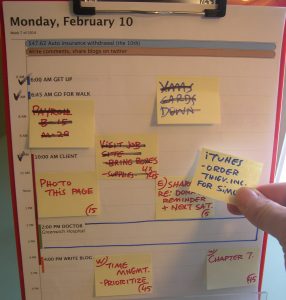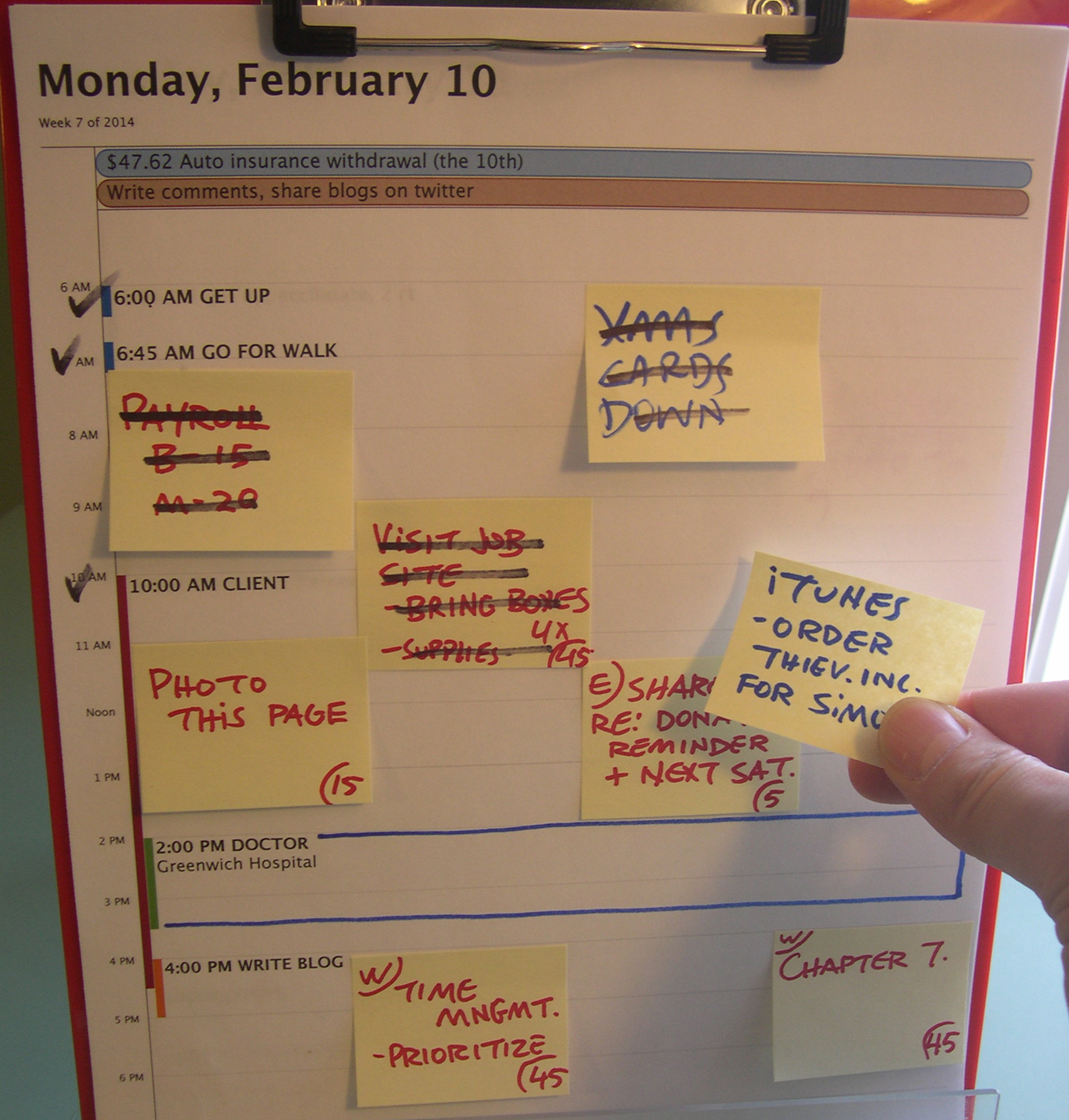What Your Time Management System May Be Missing

Fixed Time vs. Flexible Time
Digital systems seem to be better for fixed events and paper systems are best for flexible tasks. For that reason, I like a combination of digital and paper. As you can see from this photo, I start with a printout of fixed events, I have scheduled on my computer. They are synced with my smart phone and computer. I print out a week’s worth of days every Sunday. Around those fixed events, I strategically arrange 1.5” x 2” Post-It notes that contain single flexible tasks.
To-do’s that get done
Here’s why this works and why to-do lists don’t. Unlike to-do lists, this system adjusts at the speed of life. This morning, for example, I had planned to purchase a couple CD’s worth of music at the iTunes store for my brother’s birthday tomorrow. Tomorrow!? Hey, that’s pretty urgent. However, I got two calls from new potential clients this morning and naturally they had to take priority. No problem, I simply move the iTunes Post-It to later in the day. It’s cutting it close, I know, but, please, take advantage of modern technology wherever you can. I don’t have to write a new to-do list tomorrow. In fact I never have to write a to-do list ever again. I simply move the Post-It note. Sometimes I move a Post-It note so many times that it stops sticking and I realize that it is relatively unimportant.
Prioritization
What has my system got that others are missing? It’s got a mechanism for prioritization. Oh, I know there are plenty of digital systems that can collect all the priorities you may have, but they just aren’t as compelling as a boldly written Post-It on a SINGLE page of today’s events. BTW I write in red for business demands and blue for personal demands. Yes, they both occupy the same 24 hour playground but, it’s important to keep track of how many Post-It’s are devoted to each. For example, if you are seeing a day filled with blue, you immediately understand why business is at a stand still (and vice versa).
Compulsion
The reason this system works so well for me is that I devote just one spot in my office to my page of priorities, they are bold, and vying for attention. It’s compelling because it’s focused. If I have more Post-It’s than will fit on one page, then I know I am not being realistic and taking on too much. I know you can get an alert on your smart phone for tasks you want to make a point of doing, but do you really want this going off 15 times a day? Not me. I love the idea of the one page forum. I’m compelled to act when absolutely necessary, I can balance my priorities, and I can adjust.
Some Details
You may notice a letter in the upper left of these Post-It notes and a number on the lower right. Both are time savers. The letter indicates an action e.g. E = email, W = write, etc. and the number indicates an estimate of minutes. You may not always achieve your estimate of time, but at least you try to set limitations and are more aware of how much time you are devoting to a task. For example, I only gave 45 minutes to writing this blog and I am way over, but at least I am almost done. If I didn’t have the goal of working on my book, waiting in the wings, I would probably not be so close to completion.
Weekly check
You can read any time management book, double the amount of things you do in a day, and still feel unsatisfied. Why? It’s because you aren’t getting to the things that are most important in your life. Life goals are a subject for another blog, but guess what? You can still use my same system. Life goals are projects that need to be broken up into smaller tasks. Each task can also be represented by a small post it. Collect these tasks in what I call a project corral, review each week, and distribute them into your week’s schedule in a realistic manner. You may schedule the day’s event’s first, then the day’s tasks, but then you make room for your life tasks. When you break them down into attainable steps—45 minutes here, 15 minutes there—then they become realistic. On today’s schedule, for example, I have 45 minutes reserved for chapter 7 of an 8 chapter organizing book, I am writing. I would definitely consider writing a book, a life goal. Not many time management systems offer a realistic plan for achieving life goals.
Portability
Finally, this system is portable. You will already have your fixed events on your smart phone, but you can also, easily carry a day’s worth of prioritized tasks on just one page. I like carrying it in a clear folder, so I can see today’s priorities at a glance, but can also carry a note pad and collect the receipts of the day.
I should mention that a system like this, is not so necessary if you have a regular full-time job. There, you have a cleaner division between work and personal AND generally, there are other people controlling where you need to devote your time at work. When you are a stay-at-home-parent or a work-from-home professional (like me) or both, the business and personal need to dance back and forth and readjust fluidly.
I wanted to simplify my explanation of my time management system, but it’s not so easy. Why? Because there are so many elements to consider, when making your system truly realistic and effective. Did I miss anything? What works for you?
Please Share With Your Community
















